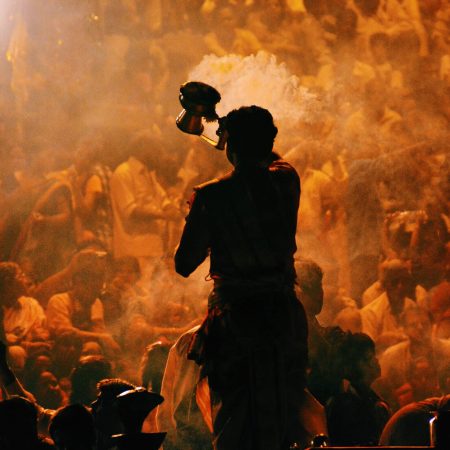
Symbolism in Hindu festivals
In order to appreciate properly the notable events in the Hindu calendar, such as Maha Shivaratri, it is important to grasp certain basic concepts and ideas that are to be found in the Vedas, the sacred scriptures of the Hindus.
This begins with understanding the creation cycle: Brahman is the source of and is inherent within creation, which comprises the living and non-living. Invisible, changeless and infinite, Brahman is in a potential, inactive state, and thus, as the Unique Truth of all that is or exists designated, in other traditions, by terms such as Absolute or Ultimate Reality, God, Lord, Supreme or Supreme Being.
Brahman, through the power of maya or mayashakti becomes manifest or active as Ishwara, bringing forth the universe that undergoes change which takes place in space and time. Thus is initiated a cycle comprising three successive stages: creation, preservation, destruction, and this concurs with our human experience. For example, a tree begins as a small seed, becomes a sapling, grows bigger into a mature tree and then comes to an end, that is, it dies or is destroyed, leaving seeds which renew the cycle afresh.
Ishwara as creator is known as Brahma, as preserver Vishnu, and as destroyer Shiva. Together they are referred to as Trimurti, that is the three facets or aspects of Ishwara. One must appreciate that Ishwara-Brahma-Vishnu-Shiva are not separate, but are the manifestations of the One Brahman who have been designated by distinct names based on their specific roles in the universe. A simple analogy would be a person who is father to his children, husband to his wife, brother to his siblings, but he is one and the same person, known by different appellations depending on which role he is identified with in a specific context.
The Vedas (Shruti) Hindu Perspective On Existence : Correspondence with Offerings
Going further in this Hindu model, creation is seen as consisting of five panchmahabhutas or elements (not, though, in the sense the term is used in chemistry), which are Space, Air, Fire, Water, and Earth. A correspondence has been established between the elements and the five sensations, and each element is as well symbolised by an item used in the performance of the puja. This is set out below schematically as follows:
- Space (Akasha) – Sound – Flowers (pushpa)
- Air (Vayu) – Touch – Incense (dhupa)
- Fire (Agni) – Vision (Form) – Light (deepa)
- Water (Apah) – Taste – Fruits, food (naivedya)
- Earth (Prithvi) – Smell – Sandalwood paste (gandha)
Why Do we 'Offer' ?
For the same reason that when we receive a gift, we express our thanks in gratitude to the giver, whoever s/he is whether friend or family. And here it is about the gift of life, and of the things created that are needed to sustain or maintain this life for a certain duration. Although we know that whatever we are offering has come to us from Ishwara, we still ‘offer’ in the same spirit that a child ‘offers’ a birthday gift to his parents using their own money. Will the parents refuse or make fun of the child? Never, they will gracefully accept it and even thank the child. So too Ishwara ‘accepts’ these offerings, and, as a result, we feel happy too. Further, making these offerings is an act of humility on our part, signifying that nothing really belongs to us.
At the same time, in making these offerings, we are acknowledging our organic link with the five elements that make up creation by symbolically representing them with the items shown above, which, it must be underlined, are all natural. An additional point about offering of fruit is that it symbolises the results or fruits of our actions which we humbly accept in return as Ishwara’s prasad as pointed out above.
In the same vein, we are recognising that as human beings, we are as one with all of creation, since we are made of the same five elements. This realisation of our connectedness with the larger whole, of our being an integral part of it, and of our mutual interdependence leads to an expanded awarenesss of both our place and that of everything else in the universe: that everything and everyone has got a rightful place in it.
A small book simply written which explains Hindu symbolism in more detail is the one written by Pujya Gurudev Swmai Chinmayananda, ‘Why do we?’ It is available at all Chinmaya Mission ashrams.
